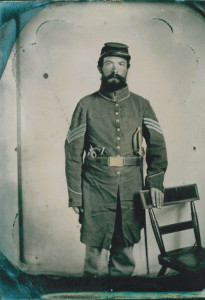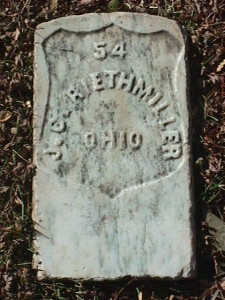Johann Gotlieb Riethmiller jumped off a boat in America in 1847. The seventeen-year-old did not record why he and his older half-brother decided to leave their German birthplace and take a long trip to another country. Johann was born in Kirchheim unter Teck in the German Kingdom of Wuertemberg on March 15, 1830. Their travels took them to Pittsburgh, just across the Ohio River from the state that Johann would eventually sign up to fight for when the War began for him nearly a lifetime later.
Our sad story of Riethmiller begins with his Civil War enlistment in Company E, 116th Ohio Volunteer Infantry Regiment. Military records reveal that he had Americanized his first name to John and some of the paperwork even reversed the vowels in his last name to Reithmiller. The men in Company E came from Monroe County on the Ohio River south of Wheeling, West Virginia. Riethmiller’s war travels took him to Virginia where he received a wound in the side during the Battle of Lynchburg [Va.] on June 17-18, 1864. He recovered from his wound and returned to duty.
 As the cold winter of 1864-1865 gave way to the warm breezes of spring, the 116th Ohio manned a defense line southeast of Richmond. The regiment was assigned to Brigadier General John W. Turner’s Independent Division in Major General John Gibbon’s newly formed Twenty-fourth Corps. Riethmiller’s brigade commander was Lieutenant Colonel Andrew Potter, formerly from the 34th Massachusetts, who was moved to the brigadier’s position because of the high officer casualties suffered in the 1864 Shenandoah Valley fighting.
As the cold winter of 1864-1865 gave way to the warm breezes of spring, the 116th Ohio manned a defense line southeast of Richmond. The regiment was assigned to Brigadier General John W. Turner’s Independent Division in Major General John Gibbon’s newly formed Twenty-fourth Corps. Riethmiller’s brigade commander was Lieutenant Colonel Andrew Potter, formerly from the 34th Massachusetts, who was moved to the brigadier’s position because of the high officer casualties suffered in the 1864 Shenandoah Valley fighting.
At mid-day on April 2, 1865, Sergeant Riethmiller and his fellow Buckeyes stood as reinforcements in line of battle about 500 yards south of Fort Gregg. The earthen walled fort stood about two miles southwest of Petersburg and blocked the Union drive to capture the strategic town held by General Robert E. Lee’s army.
The fort bristled with Confederate soldiers and guns. At 1 p.m., the first Union attack wave charged forward across hundreds of yards of open ground. Rebel bullets and canister balls zipped into the blue uniformed troops of Brigadier General Robert Foster’s division – some two thousand men. Those soldiers lucky enough to avoid getting hit soon approached the fort’s fourteen foot high walls only to discover another problem. A deep water-filled moat surrounded Fort Gregg on three sides.
The first attack deteriorated as Foster’s men sardined themselves into the moat and tried to clamber up the steep muddy walls. Twenty-eight-year-old Lieutenant Colonel Wilbert B. Teters soon received orders for his 116th Ohio troops to charge. Teters’ 350 men raced forward with the 34th Massachusetts on the right and the 12th West Virginia on the left.
 Sergeant Riethmiller led a squad around and over the numerous Union bodies that blocked their way. Near the moat he saw a fold in the ground that might provide some cover for his men and the group dove to the ground. Moments later he rose up to continue forward, but a rebel on the fort’s parapet sighted in the thirty-five-year-old German born American. The Southerner pulled the trigger on his rifle and Riethmiller fell to the ground.
Sergeant Riethmiller led a squad around and over the numerous Union bodies that blocked their way. Near the moat he saw a fold in the ground that might provide some cover for his men and the group dove to the ground. Moments later he rose up to continue forward, but a rebel on the fort’s parapet sighted in the thirty-five-year-old German born American. The Southerner pulled the trigger on his rifle and Riethmiller fell to the ground.
Union troops eventually overwhelmed Fort Gregg, capturing or killing the entire Confederate garrison save one lucky escapee. A short time later, a Federal burial detail began its sad work. When they finally tossed their shovels down, 122 new Union headboards poked out of the ground in front of Fort Gregg’s moat. Mounds of dirt behind the fort indicated the graves of 57 Confederate defenders. Carved into one of these boards was John Riethmiller’s name. He missed surviving the war by only one week. His body would later be moved to a nearby national cemetery called Poplar Grove.
I want to thank Sergeant John Riethmiller’s great-great grandson, Fred Reithmiller, for contacting me after he had read The Confederate Alamo and providing more background info plus the great war-era photo.

Thanks John. I’ve got a lot of family members helping me research now, thanks in-part to you. Great piece!
I am also Sergeant John Riethmiller’s great great grandson, and have the original tin type of the above photo! I was named after him.
Hey Jon. I was actually named after his brother who (as you know) served in the WV Artillery. Kind of cool, huh?
Hey Fred, I actually didn’t know about his brother serving in the WV Artillery. The information from his relatives was all lost, as far as we knew, John and his brother lost contact when they got to the US. What regiment did he serve in, and what town was it based in? That is very cool! Give me an email sometime, my address is jriethmiller@yahoo.com
Jon, Just sent you a long email with several photos. I’m referring to George Frederick Riethmiller who served in the 1st WV Light Artillery. He came to America 2 years after Johann Gotlieb (J.G.) I believe you are talking about Johaan Christian, who was a [step-]brother who immigrated with J.G in 1851. My theory is that J.C. served in the 47th OVI but I have yet to prove this completely. If you read my email you’ll see the details and the photos.
Hey Jon, my father reminded me that J.C. and J.G. actually immigrated in 1847, not 1851. I believe you are a direct descendant of J.G.’s second son, William Herman, whereas I come from his older brother Alexander. Very Cool!
Fred,
JG had two children that survived to adulthood, Alexander and Hermann. Hermann had one child, William Herman. Bill, as my dad called him, had two sons, Lee and Lynn. Lynn is Jon’s father.
Thanks, John Fox, for this great piece. My father would have been very proud and very greatful.
Dick Riethmiller, Fred’s dad.
Fred & Jon, Thank you for your comments. I apologize for taking so long to post here but due to technical issues I’m just now seeing what you both wrote. Fred, thank you again for letting me use Sgt. Riethmiller’s photo and I think it is really neat that you met Jon through this information.
Jon,
We obtained JG’s picture from your grandparents. The picture was in a double frame, but the picture that had been on the other side was missing. Could that have been Margareta? and do you have it?
Dick
Fred, just wondered if you knew our son jon riethmiller passed away in april, 2013.
Joyce, I am so very sorry and saddened to hear this news. I just found out that Lee past in October, as well. Our sincerest condolences from our family to yours. You will be in our thoughts and prayers.
We both, Fred and I (Dick) just found out and we sent a card yesterday, 11/21. So sorry to hear, he was so interested in family.
Hi Fred and Dick,
This is Lee’s wife Jessa. Thank you for sharing this wonderful post, it’s very moving to read. I know my dear Lee was always so proud of the valor his great-grandfather Johann had shown during the end days of the Civil War.
Those we hold in our hearts never truly leave us. They live on through the love they brought into our lives.
Hi Fred and Dick,
This is Lee’s wife Jessa. Thank you for sharing this post, it’s very moving to read. I know my dear Lee was always proud of the valor and bravery his great-grandfather Johann had shown at the Battle of Gettysburg during the end days of the Civil War.
Those we hold in our hearts never truly leave us. They live on through the love they brought into our lives.
My name is Rich Riethmiller
My father was Richard C Riethmiller from Spring hill (part of Pittsburgh)
His parents died when he was 8 years old. I know nothing of his past. He died over 50 years ago.
I am curious if I am related to either of these great men
If any of you know of his past, I would be grateful